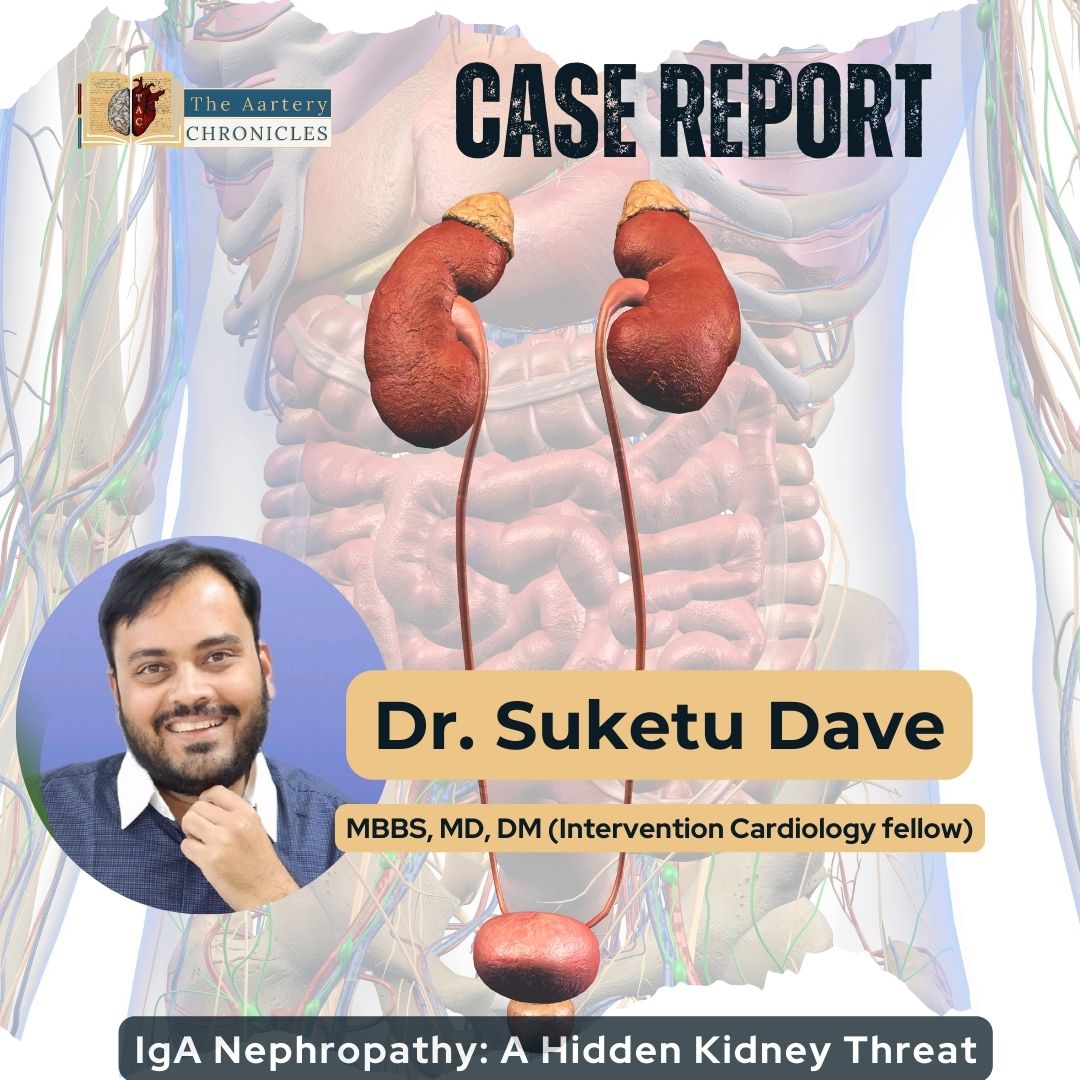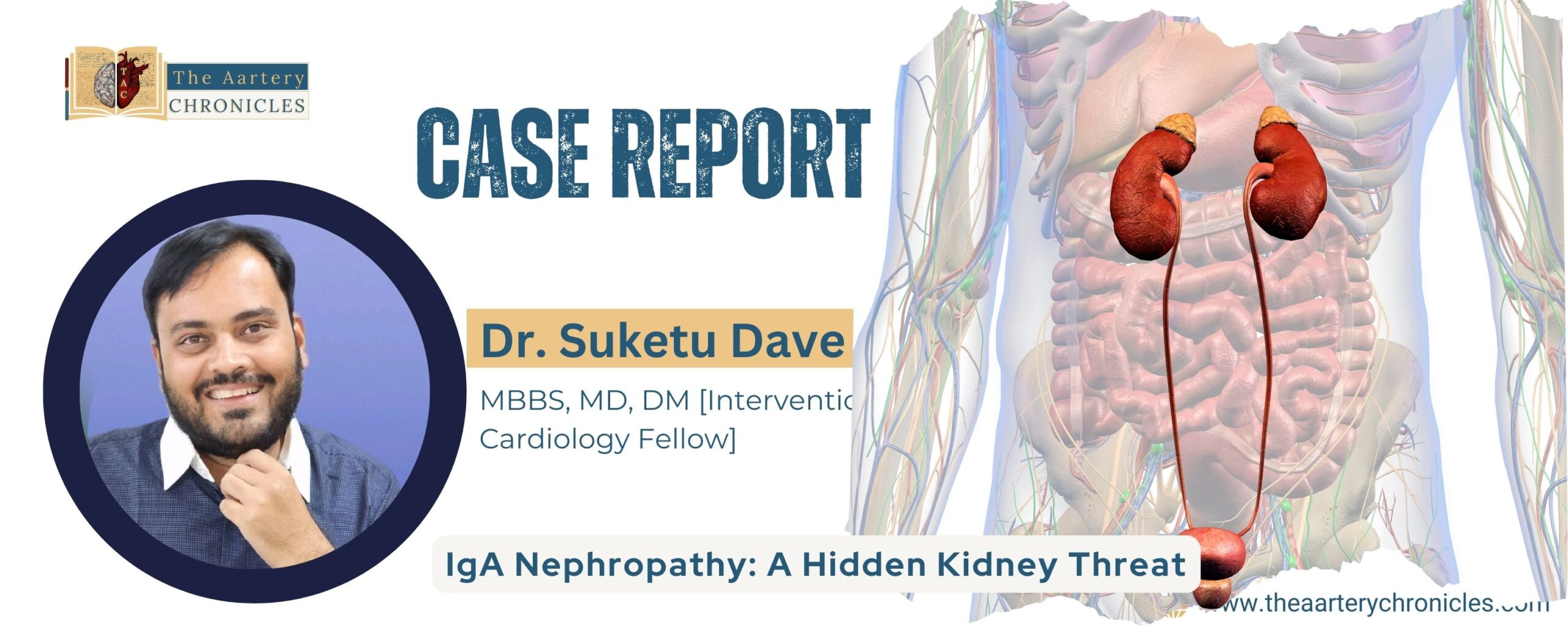

Case Study: IgA Nephropathy in a Hypertensive Patient
Background
This real-life case of a 43-year-old woman diagnosed with IgA Nephropathy (Berger’s Disease) reveals how a simple routine urine test helped uncover a serious kidney condition that had silently progressed. The case highlights why secondary hypertension must not be ignored and how early detection with UACR (Urine Albumin-to-Creatinine Ratio) and renal biopsy can prevent irreversible kidney damage.
Understanding IgA Nephropathy: A Hidden Kidney Threat
This case involves a 43-year-old female who had been experiencing persistent headaches for two years. She consulted a senior physician (not me) and was diagnosed with hypertension.
- Her blood pressure was recorded as 160/90 mmHg, and she was prescribed a beta-blocker (Metoprolol).
- Her symptoms improved, and her blood pressure normalised.
Another physician later increased the dose of Metoprolol, and no further evaluation was pursued.
She remained stable until three months ago, when she approached me for a routine health check-up. As part of the evaluation, I recommended standard investigations.
Urine Test Reveals the First Clue- Routine Investigations Raise Red Flags
Routine urinalysis showed:
- +2 to +3 albumin
- Presence of RBCs and WBCs
To investigate further, I ordered a Urine Albumin-to-Creatinine Ratio (UACR), a surrogate marker for 24-hour urinary protein loss. The result was 1.5–2 grams, indicative of nephritic-range proteinuria.
Although she also had pus cells, for which I treated her empirically for UTI, a repeat UACR still showed 2.2 grams, reinforcing the need for further evaluation.
Renal Imaging and the Decision for Biopsy
- Ultrasound KUB: Normal
- Renal arteries: Normal on Doppler
Despite normal imaging and stable creatinine, I was suspicious of glomerular pathology, especially IgA nephropathy, the most common cause of glomerulonephritis in younger adults worldwide.
Despite normal imaging and stable creatinine, I was suspicious of glomerular pathology, especially IgA nephropathy, the most common cause of glomerulonephritis in younger adults worldwide.
Dr Suketu Dave Tweet
Confirming Diagnosis: IgA Nephropathy (Berger’s Disease)
I advised a USG-guided renal biopsy, which confirmed IgA Nephropathy (Berger’s Disease).
“Renal biopsy remains the gold standard for confirming IgA nephropathy.”
- Her serum creatinine was normal
- She had no gross oedema
- Hypertension was well controlled but needed optimization
Treatment Strategy: Protecting the Kidneys
I changed her antihypertensive from Metoprolol to Enalapril (Envas), an ACE inhibitor with proven renal-protective effects and proteinuria reduction.
- Started at 10 mg HS, gradually titrated to 10 mg BD
- No immunosuppressive therapy was started because:
“There is no proven role of steroids or immunosuppression unless the patient has rapidly progressive glomerulonephritis (RPGN).”
Ongoing Monitoring and Follow-Up
She is currently under regular follow-up. We are monitoring:
- Serum creatinine
- Urinary protein levels
- Ultrasound KUB findings
Our goal is to delay
- Renal function decline
- Prevent dialysis
- Avoid early renal transplantation
Why This Case Matters: Don’t Ignore Secondary Causes
“This case teaches us to always think beyond primary hypertension.”
In young hypertensive patients, especially those without a strong family history or with unusual features like proteinuria, secondary causes must be explored.
What is IgA Nephropathy (Berger’s Disease)?
IgA Nephropathy is a chronic kidney disease where IgA antibodies deposit in the kidneys’ glomeruli, causing inflammation and damage.
Typical Features Include:
- Blood in urine (hematuria)
- Proteinuria
- Elevated blood pressure
- Normal kidney imaging initially
- Confirmed via renal biopsy
Take-Home Points from This Case
- Never ignore urinary abnormalities in a hypertensive patient.
- Always screen for proteinuria and RBCs in the urine.
- Use UACR to detect glomerular damage early.
- Renal biopsy is critical for diagnosis.
- ACE inhibitors like Enalapril are the cornerstone of therapy.
- Early intervention can delay ESRD and improve long-term outcomes.
Conclusion
IgA Nephropathy may remain silent but is not harmless. This case highlights the power of routine urine testing and the need for a high index of suspicion in young hypertensives. With timely diagnosis and renal-protective therapy, we can delay or even prevent chronic kidney failure.
Always think twice before dismissing a mildly abnormal urine report; your kidneys might be trying to tell you something.
Dr Dave has been working as a consultant physician, Diabetologist, and intensivist at Kamubala Polyclinic Vadodara Gujarat. He is on the verge of completing his DM in Interventional Cardiology from the highly prestigious U. N. Mehta Institute of Cardiology and Research Centre, Ahmedabad, having secured an impressive All India Rank 5 in the DM Cardiology Entrance Examination.
Disclaimer: This case is provided by expert Dr. Suketu Dave. The opinions and recommendations shared are those of Dr. Suketu Dave and are intended for awareness purposes.









